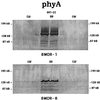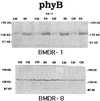A photoperiod-insensitive barley line contains a light-labile phytochrome B
- PMID: 10069841
- PMCID: PMC32084
- DOI: 10.1104/pp.119.3.1033
A photoperiod-insensitive barley line contains a light-labile phytochrome B
Abstract
Barley (Hordeum vulgare L.) is a long-day plant whose flowering is enhanced when the photoperiod is supplemented with far-red light, and this promotion is mediated by phytochrome. A chemically mutagenized dwarf cultivar of barley was selected for early flowering time (barley maturity daylength response [BMDR]-1) and was made isogenic with the cultivar Shabet (BMDR-8) by backcrossing. BMDR-1 was found to contain higher levels of both phytochrome A and phytochrome B in the dark on immunoblots with monoclonal antibodies from oat (Avena sativa L.) that are specific to different members of the phytochrome gene family. Phytochrome A was light labile in both BMDR-1 and BMDR-8, decreasing to very low levels after 4 d of growth in the light. Phytochrome B was light stable in BMDR-8, being equal in both light and darkness. However, phytochrome B became light labile in BMDR-1 and this destabilization of phytochrome B appeared to make BMDR-1 insensitive to photoperiod. In addition, both the mutant and the wild type lacked any significant promotion of flowering in response to a pulse of far-red light given at the end of day, and the end-of-day, far-red inhibition of tillering is normal in both, suggesting that phytochrome B is not involved with these responses in barley.
Figures




Similar articles
-
Protein Differences between Two Isogenic Cultivars of Barley (Hordeum vulgare L.) that Differ in Sensitivity to Photoperiod and Far-Red Light.Plant Physiol. 1992 Apr;98(4):1444-50. doi: 10.1104/pp.98.4.1444. Plant Physiol. 1992. PMID: 16668813 Free PMC article.
-
Far-red light-insensitive, phytochrome A-deficient mutants of tomato.Mol Gen Genet. 1995 Jan 20;246(2):133-41. doi: 10.1007/BF00294675. Mol Gen Genet. 1995. PMID: 7862083
-
Flowering responses to altered expression of phytochrome in mutants and transgenic lines of Arabidopsis thaliana (L.) Heynh.Plant Physiol. 1995 Aug;108(4):1495-503. doi: 10.1104/pp.108.4.1495. Plant Physiol. 1995. PMID: 7659750 Free PMC article.
-
Overexpression of rice phytochrome A partially complements phytochrome B deficiency in Arabidopsis.Planta. 1999 Jan;207(3):401-9. doi: 10.1007/s004250050498. Planta. 1999. PMID: 9951735
-
Kinetics and time dependence of the effect of far red light on the photoperiodic induction of flowering in wintex barley.Plant Physiol. 1979 Dec;64(6):1015-21. doi: 10.1104/pp.64.6.1015. Plant Physiol. 1979. PMID: 16661084 Free PMC article.
Cited by
-
Elongated mesocotyl1, a phytochrome-deficient mutant of maize.Plant Physiol. 2002 Sep;130(1):155-63. doi: 10.1104/pp.006411. Plant Physiol. 2002. PMID: 12226496 Free PMC article.
-
CONSTANS is a photoperiod regulated activator of flowering in sorghum.BMC Plant Biol. 2014 May 28;14:148. doi: 10.1186/1471-2229-14-148. BMC Plant Biol. 2014. PMID: 24884377 Free PMC article.
-
Genome-wide screening of meta-QTL and candidate genes controlling yield and yield-related traits in barley (Hordeum vulgare L.).PLoS One. 2024 May 20;19(5):e0303751. doi: 10.1371/journal.pone.0303751. eCollection 2024. PLoS One. 2024. PMID: 38768114 Free PMC article.
-
Phytochrome signaling mechanism.Arabidopsis Book. 2004;3:e0074.1. doi: 10.1199/tab.0074.1. Epub 2004 Jul 6. Arabidopsis Book. 2004. PMID: 22303226 Free PMC article. No abstract available.
-
Photomorphogenic responses in maize seedling development.Plant Physiol. 2003 Dec;133(4):1578-91. doi: 10.1104/pp.103.029694. Epub 2003 Nov 26. Plant Physiol. 2003. PMID: 14645729 Free PMC article.
References
-
- Biyashev RM, Ragab RA, Maughan PJ, Saghai Maroof MA. Molecular mapping, chromosomal assignment, and genetic diversity analysis of phytochrome loci in barley (Hordeum vulgare) J Hered. 1997;88:21–26.
LinkOut - more resources
Full Text Sources

